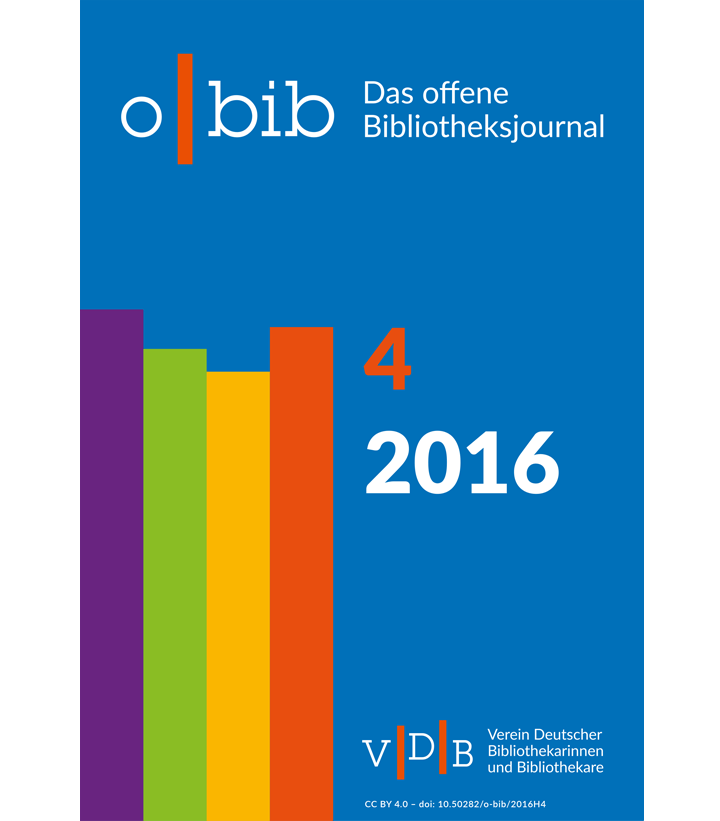Zusammenführen was zusammengehört – Intellektuelle und automatische Erfassung von Werken nach RDA
DOI:
https://doi.org/10.5282/o-bib/2016H4S144-155Keywords:
RDA, Resource Description and Access, Werk, Cluster, ClusterverfahrenAbstract
Der Beitrag will die Erschließungspraxis der Deutschen Nationalbibliothek im ersten Implementierungsschritt der RDA zur Angabe der Werkebene darstellen, Erfahrungen zur grundsätzlichen Vorgehensweise und zu Sonderregelungen vermitteln und einen Ausblick in die Zukunft bieten. Die Angabe der Werkebene als Kernelement des neuen Standards wird bei der Erschließung von Ressourcen in der Deutschen Nationalbibliothek immer berücksichtigt. Bei der intellektuellen Erschließung von Monografien wird das Element als Normdatensatz oder als textuelle Angabe im Katalogisat erfasst. Allerdings setzt die derzeitige Praxis auch auf zukünftige automatische Clusterverfahren. Der erreichte Stand zu Algorithmen und Testläufen für das Werkclustering soll ebenso aufgezeigt werden, wie die daraus resultierenden Entscheidungen und die weitere Perspektive. Von zentraler Bedeutung ist die Frage, ob und unter welchen Bedingungen auf der Basis der Werkcluster Normdatensätze für die Gemeinsame Normdatei (GND) generiert werden können, um sie im deutschen Sprachraum kooperativ zu nutzen und sie in der Linked-Data-Cloud zu vernetzen.
This article explains how works are catalogued at the Deutsche Nationalbibliothek (German National Library) in the first implementation step of RDA. It discusses experiences with the general approach as well as some special rules and points out future prospects. When cataloguing resources at the Deutsche Nationalbibliothek, the work entity is always included as the work elements are core elements of the new standard. If the cataloguing is done intellectually, the work entity is described either as a link to an authority record or as a textual string within the description of the resource. However, the current practice builds also on automatic clustering of works in the future. The state of the art of automatic cluster algorithms and their evaluation and testing is described as well as the next steps for the future. An essential question is whether and under which conditions authority records for works can be generated on the basis of automatic clustering in order to use them cooperatively and to position them as crosspoints in the linked data cloud.
References
Gatenby, Janifer, Green, Richard O., Oskins Michael W. und Thornburg, Gail. „GLIMIR: Manifestation and Content Clustering within WorldCat.” Code4Lib journal 17 (2012). Zuletzt geprüft am 26.07.2016. http://journal.code4lib.org/articles/6812
Hickey, Thomas B und Toves, Jenny. FRBR Work-Set Algorithm. Version 2.0. Dublin Ohio: OCLC Online Computer Library Center, Inc. (Research division), 2009. Zuletzt geprüft am 26.07.2016. http://www.oclc.org/research/activities/past/orprojects/frbralgorithm/2009-08.pdf
Pfeffer, Magnus. „Using Clustering Across Union Catalogues to Enrich Entries with Indexing Information.” In Data Analysis, Machine Learning and Knowledge Discovery, herausgegeben von Myra Spiliopoulou, Lars Schmidt-Thieme und Ruth Janning.437-445. Cham: Springer International Publishing, 2014. https://dx.doi.org/10.1007/978-3-319-01595-8
Wiesenmüller, Heidrun und Pfeffer, Magnus. „Abgleichen, anreichern, verknüpfen : das Clustering-Verfahren – eine neue Möglichkeit für die Analyse und Verbesserung von Katalogdaten.“ BuB: Forum Bibliothek und Information, Nr. 9 (2013): 625-629.
Downloads
Published
Issue
Section
License
Copyright (c) 2016 Barbara Pfeifer, Renate Polak-Bennemann

This work is licensed under a Creative Commons Attribution 4.0 International License.





